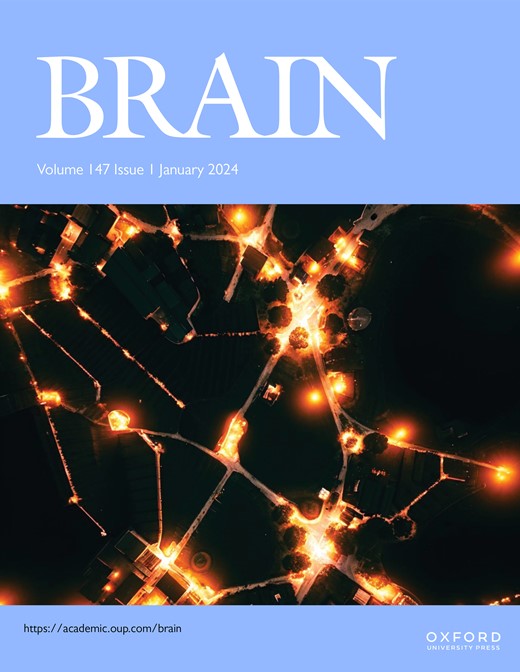急性和慢性移植物抗宿主病的中枢神经系统表现。
IF 10.6
1区 医学
Q1 CLINICAL NEUROLOGY
引用次数: 0
摘要
尽管越来越多的证据支持急慢性移植物抗宿主病(CNS-GvHD)存在中枢神经系统受累的情况,但该病的特征和病程在很大程度上仍不为人所知。在这项多中心回顾性研究中,我们分析了根据预定诊断标准确诊为可能的中枢神经系统抗宿主病(pCNS-GvHD)的 66 例患者的临床、生物学、放射学和组织病理学特征以及临床病程。然后,根据pCNS-GvHD是发生在异体造血干细胞移植后第100天之前还是之后,对结果进行对比。造血干细胞移植与pCNS-GvHD发病之间的中位时间为149天(IQ25-75 48-321),44%的患者pCNS-GvHD发病发生在移植后第100天之前。发病时最常见的症状是认知障碍(41%)、瘫痪(21%)、意识改变(20%)、感觉障碍(18%)和头痛(15%)。移植后第100天之前或之后发生的中枢神经系统-GvHD患者的临床表现无明显差异。57%的患者在脑磁共振成像中发现了与临床表现相符的异常,而只有7%的患者在CT中发现了异常。7名患者有脊髓磁共振成像异常记录,他们都是在移植后第100天后发生的中枢神经系统-后天免疫缺损。56%的患者脑脊液中白细胞计数增加(中位数为18个/μL)。对12个标本进行了组织病理学分析,其中10个标本提示为中枢神经系统-后天性缺血性坏死。所有相合标本均显示实质和血管周围有 CD3+ 和 CD163+ 细胞浸润。97%的患者接受了免疫抑制治疗,27%的患者获得了完全临床应答,47%的患者部分好转,6%的患者病情稳定。移植后第100天之前或之后发生pCNS-GvHD的患者对免疫抑制疗法的反应没有明显差异。在最初对治疗有反应的患者中,31%的患者出现了临床复发。发生中枢神经系统-GvHD后的一年总生存率为41%。造血干细胞移植后第100天前发病(HR[95%CI]:2.1 [1.0-4.5];P=0.041)和初次发病时意识改变(HR[95%CI]:3.0 [1.3-6.7];P=0.0077)与一年总存活率降低有关。在存活的患者中,61%有神经系统后遗症。这项研究证实,异体造血干细胞移植后可能会出现免疫介导的中枢神经系统表现。这些症状可能与急性和慢性 GvHD 相关,预后较差。临床表现以及放射学和生物学结果似乎各不相同。本文章由计算机程序翻译,如有差异,请以英文原文为准。
Central nervous system manifestations in acute and chronic graft-versus-host disease.
Despite the growing evidence supporting the existence of CNS involvement in acute and chronic graft-versus-host disease (CNS-GvHD), the characteristics and course of the disease are still largely unknown. In this multicenter retrospective study, we analyzed the clinical, biological, radiological, and histopathological characteristics, as well as the clinical course of 66 patients diagnosed with possible CNS-GvHD (pCNS-GvHD), selected by predetermined diagnostic criteria. Results were then contrasted depending on whether pCNS-GvHD occurred before or after day 100 following allogeneic hematopoietic stem cell transplantation. Median time between hematopoietic stem cell transplantation and pCNS-GvHD onset was 149 days (IQ25-75 48-321), and pCNS-GvHD onset occurred before day 100 following transplantation in 44% of patients. The most frequent findings at presentation were cognitive impairment (41%), paresis (21%), altered consciousness (20%), sensory impairment (18%), and headache (15%). Clinical presentation did not significantly differ between patients with pCNS-GvHD occurring before or after day 100 following transplantation. Brain MRI found abnormalities compatible with the clinical picture in 57% of patients, while CT detected abnormalities in only 7%. Seven patients had documented spinal cord MRI abnormalities, all of them with pCNS-GvHD occurring after day 100 following transplantation. In the cerebrospinal fluid, white blood cell count was increased in 56% of the population (median 18 cells/μL). Histopathological analyses were performed on 12 specimens and were suggestive of pCNS-GvHD in 10. All compatible specimens showed parenchymal and perivascular infiltration by CD3+ and CD163+ cells. Immunosuppressive therapy was prescribed in 97% of patients, achieving complete clinical response in 27%, partial improvement in 47% and stable disease in 6%. Response to immunosuppressive therapy did not significantly differ between patients with pCNS-GvHD occurring before or after day 100 following transplantation. Clinical relapse was observed in 31% of patients who initially responded to treatment. One-year overall survival following pCNS-GvHD onset was 41%. Onset before day 100 following hematopoietic stem cell transplantation (HR [95%CI]: 2.1 [1.0-4.5]; P=0.041) and altered consciousness at initial presentation (HR [95%CI]: 3.0 [1.3-6.7]; P=0.0077) were associated with a reduced one-year overall survival probability. Among surviving patients, 61% had neurological sequelae. This study supports that immune-mediated CNS manifestations may occur following allo-HSCT. These can be associated with both acute and chronic GvHD and carry a grim prognosis. The clinical presentation as well as the radiological and biological findings appear variable.
求助全文
通过发布文献求助,成功后即可免费获取论文全文。
去求助
来源期刊

Brain
医学-临床神经学
CiteScore
20.30
自引率
4.10%
发文量
458
审稿时长
3-6 weeks
期刊介绍:
Brain, a journal focused on clinical neurology and translational neuroscience, has been publishing landmark papers since 1878. The journal aims to expand its scope by including studies that shed light on disease mechanisms and conducting innovative clinical trials for brain disorders. With a wide range of topics covered, the Editorial Board represents the international readership and diverse coverage of the journal. Accepted articles are promptly posted online, typically within a few weeks of acceptance. As of 2022, Brain holds an impressive impact factor of 14.5, according to the Journal Citation Reports.
 求助内容:
求助内容: 应助结果提醒方式:
应助结果提醒方式:


